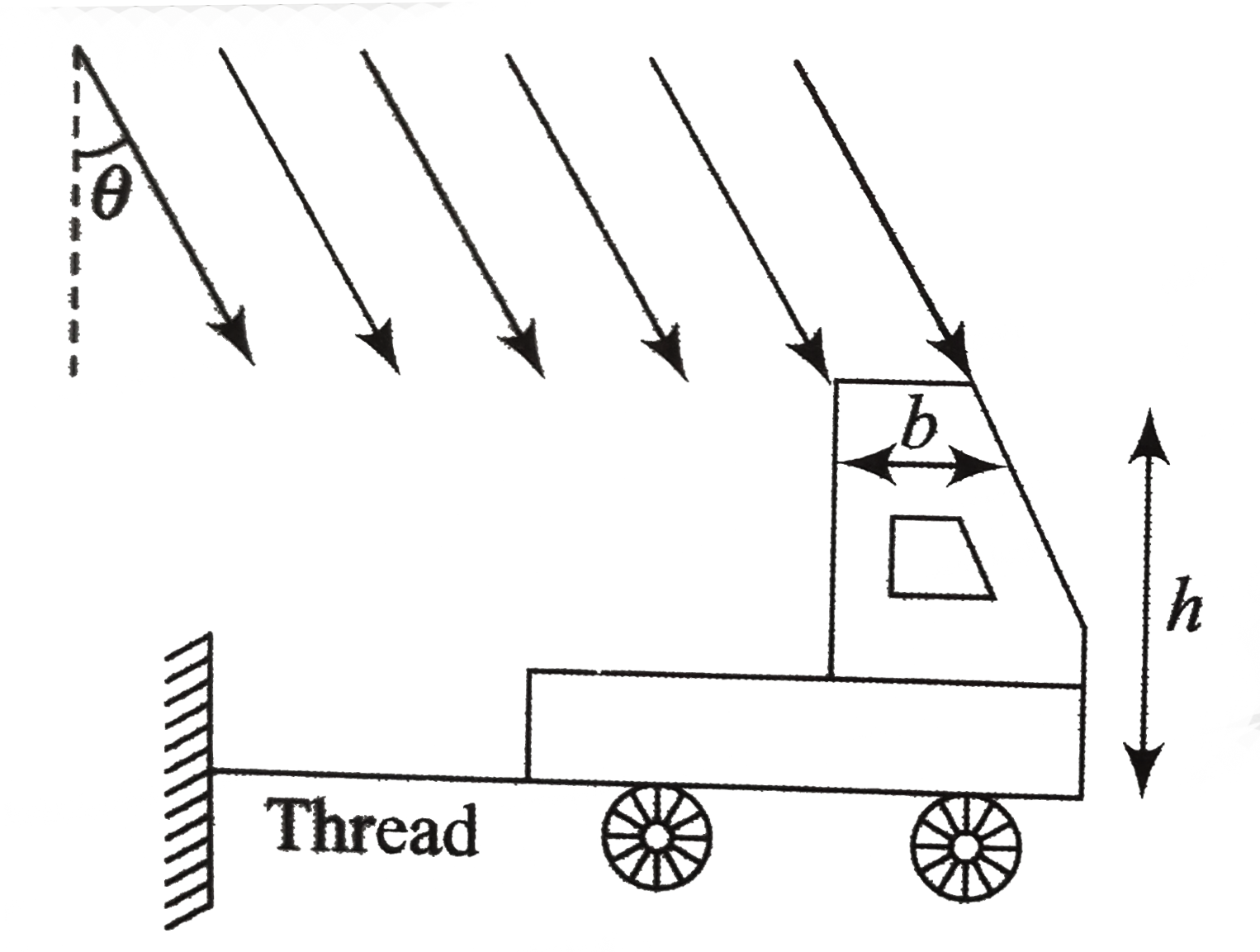
A toy truck has dimensions as shown in fig. and its width, normal to the plane of this paper, is d. The sun rays are incident on it as shiwn in the figure. If intensity of rays is I and all surfaces of truck are perfectly black, calculate tension in the thread used to keep the truck stationary. Neglect friction.
Step by step video & image solution for A toy truck has dimensions as shown in fig. and its width, normal to the plane of this paper, is d. The sun rays are incident on it as shiwn in the figure. If intensity of rays is I and all surfaces of truck are perfectly black, calculate tension in the thread used to keep the truck stationary. Neglect friction. by Physics experts to help you in doubts & scoring excellent marks in Class 12 exams.
Topper's Solved these Questions
- BOOK - PHYSICS GALAXY - ASHISH ARORACHAPTER - PHOTOELECTRIC EFFECT AND MATTER WAVESEXERCISE - Advance MCQ28videos
PHOTOELECTRIC EFFECT AND MATTER WAVES
- BOOK - PHYSICS GALAXY - ASHISH ARORACHAPTER - NUCLEAR PHYSICS AND RADIOACTIVITYEXERCISE - Concptual MCQs48videos
NUCLEAR PHYSICS AND RADIOACTIVITY
- BOOK - PHYSICS GALAXY - ASHISH ARORACHAPTER - THERMODYNAMICS LAWS & SPECIFIC HEATS OF GASES EXERCISE - Practice Exercise 3.411videos
THERMODYNAMICS LAWS & SPECIFIC HEATS OF GASES
Similar Questions
A uniform, horizontal parallel beam of light is incident upon a prism as shown. The prism is in the shape of a quarter cylinder, of radius 5cm, and has refractive index 5/3. The width of the regionat which the incident rays after normal incidence on plane surface and subsequent refraction at curved surface intersect on x axis is (Neglect the ray which travels along x-axis)
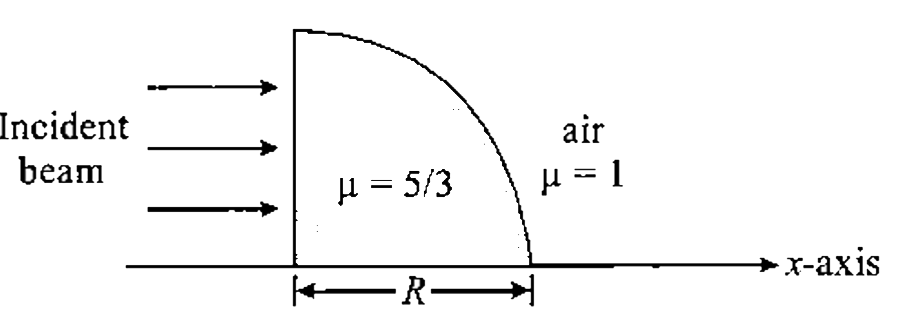 View Solution
View Solution(i) Four small blocks are interconnected with light strings and placed over a fixed sphere as shown. Blocks A, B and C are identical each having mass m = 1 kg. Block D has a mass of m´ = 2 kg. The coefficient of friction between the blocks and the sphere is μ=0.5. The system is released from the position shown in figure.
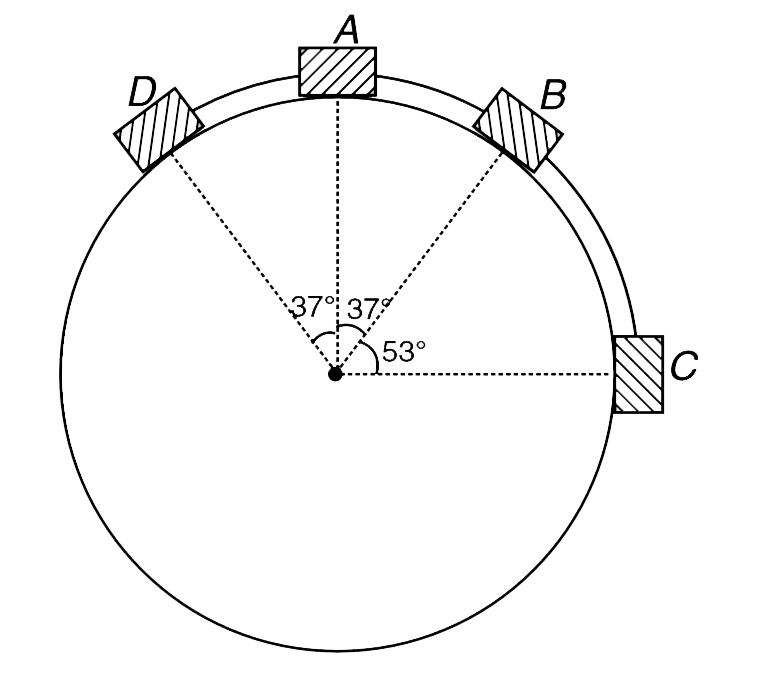
(a) Find the tension in each string. Which string has largest tension?
(b) Find the friction force acting on each block.
[Take tan37∘=34,g=10m/s2]
(ii) A fixed square prism ABCD has its axis horizontal and perpendicular to the plane of the figure. The face AB makes 45∘ with the vertical. On the upper faces AB and BC of the prism there are light bodies P and Q respectively. The two bodies (P and Q) are connected using a string S1 and strings S0 and S2 are hanging from P and Q respectively. All strings are mass less, and inextensible. StringS1 is horizontal and the other two strings are vertical. The coefficient of friction between the bodies and the prism is μ0 . Assume that P and Q always remain in contact with the prism.
(a) If tension in S0 is T0, find the minimum tension (T1) in S1 to keep the body P at rest.
(b) A mass M0 is tied to the lower end of string S0 and another mass m2 is tied to S2 . Find the minimum value of m2 so as to keep P and Q at rest.
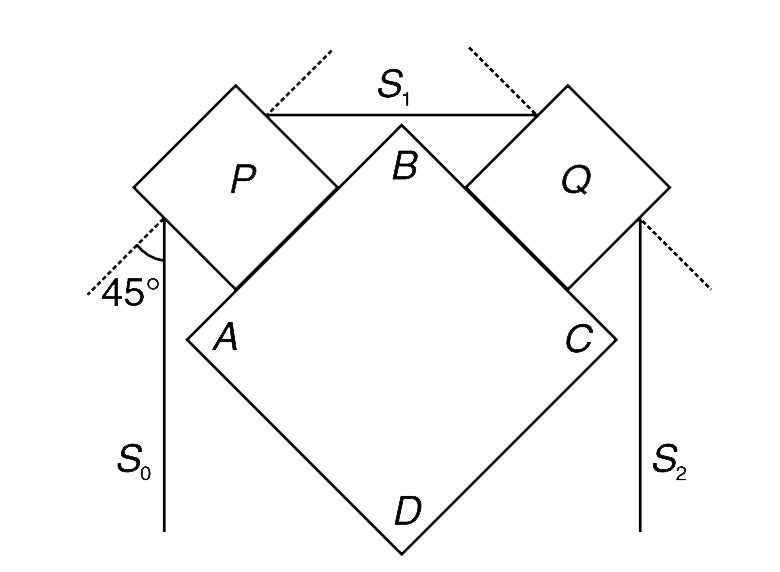 View Solution
View Solution
Knowledge Check
- Question 1 - Select One
Pulfrich refractometer is used to measure the refractive index of solids and liquid. It consist of right angled prism. A having its two faces perfectly plane. One of the face is horizontal and the other is vertical as shown is figure. The solid B whose refractive index is to be determined is taken having two faces cut perpendicular to one another. Light is incident in a direction parallel to the horizontal surface so that the light entering the prism A is at critical angle C. Finally, it emerges from the prism at an angle i. Let the refractive index of the solid be μ and that of the prism A be μ0 (which is known). Here μ0>μ and by measuring i, μ can be determinged.
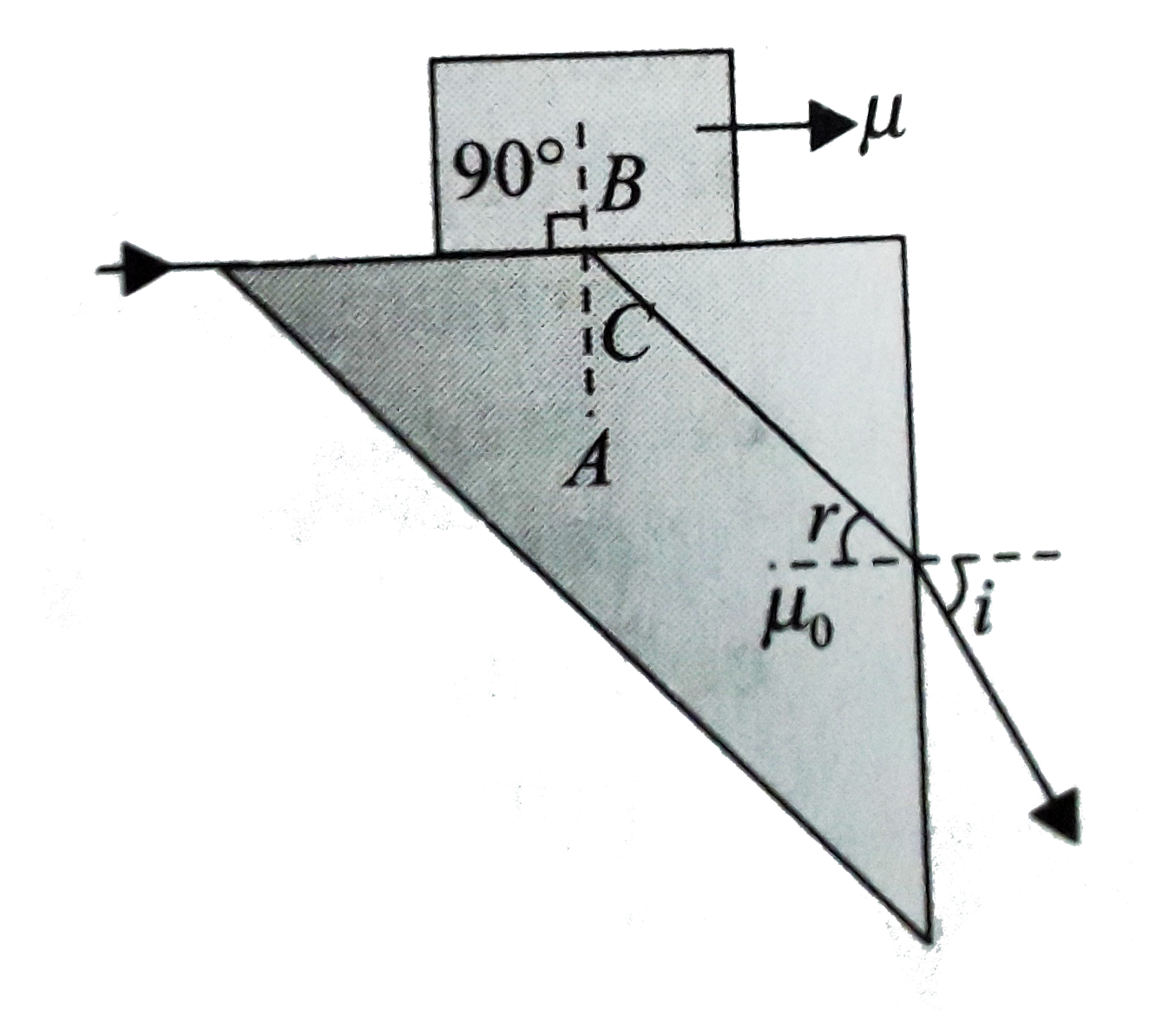
Q. Refractive index of the solid (μ) in terms of μ0 and i isA1.21B√2C1D√3/2 - Question 2 - Select One
When the Sun had descended on the other side of the narrow strip of land, and a day of sunshine was followed by a night without twilight, the new lighthouse keeper was in his place evidently, for the lighthouse was casting its bright rays on the water as usual. The night was perfectly calm, silent, genuinely tropical, filled with a transparent haze, forming around the Moon a great coloured rainbow with soft, unbroken edges, the sea was moving only because the tide raised it.
The keeper on the balcony seemed from below like a small black point. He tried to collect his thoughts and take in his new position, but his mind was under too much pressure to move with regularity. He felt somewhat as a hunted beast feels when at last it has found refuge from pursuit on some inaccessible rock or in a cave. Now on that rock he can simply laugh at his previous wanderings, his misfortunes and failures. He was in truth like a ship whose masts, ropes and. sails had been broken and rent by a tempest and might have been cast to the bottom of the sea, a ship on which the tempest had hurled waves and spat form, but which still wound its way to the harbour.
The pictures of that storm passed quickly through his mind as he compared it with the calm future now beginning. Part of his wonderful adventures he had related to Mr. Shyam when he was interviewed for the job of the keeper, he had not mentioned however, thousands of other incidents. It has been his misfortune that as often as he pitched his tent and fixed his fireplace to settle down permanently, some wind tore the stakes of his tent, whirled away the first and bore him on towards destruction.
Looking now from the balcony of the tower at the illuminated waves, he remembered everything through which he had passed. He had campaigned in the four parts of the world and in wandering had tried almost every occupation.
"He was in truth like a ship".
The figure of speech––––––––––––––––– used in the above sentence isAmetaphorBpersonificationChyperboleDsimile - Question 3 - Select One
When the Sun had descended on the other side of the narrow strip of land, and a day of sunshine was followed by a night without twilight, the new lighthouse keeper was in his place evidently, for the lighthouse was casting its bright rays on the water as usual. The night was perfectly calm, silent, genuinely tropical, filled with a transparent haze, forming around the Moon a great coloured rainbow with soft, unbroken edges, the sea was moving only because the tide raised it.
The keeper on the balcony seemed from below like a small black point. He tried to collect his thoughts and take in his new position, but his mind was under too much pressure to move with regularity. He felt somewhat as a hunted beast feels when at last it has found refuge from pursuit on some inaccessible rock or in a cave. Now on that rock he can simply laugh at his previous wanderings, his misfortunes and failures. He was in truth like a ship whose masts, ropes and. sails had been broken and rent by a tempest and might have been cast to the bottom of the sea, a ship on which the tempest had hurled waves and spat form, but which still wound its way to the harbour.
The pictures of that storm passed quickly through his mind as he compared it with the calm future now beginning. Part of his wonderful adventures he had related to Mr. Shyam when he was interviewed for the job of the keeper, he had not mentioned however, thousands of other incidents. It has been his misfortune that as often as he pitched his tent and fixed his fireplace to settle down permanently, some wind tore the stakes of his tent, whirled away the first and bore him on towards destruction.
Looking now from the balcony of the tower at the illuminated waves, he remembered everything through which he had passed. He had campaigned in the four parts of the world and in wandering had tried almost every occupation.
"He was in truth like a ship".
The figure of speech used in the above sentence isAmetaphorBpersonificationChyperboleDsimile
(a) A parallel beam of monochromatic light of wavelength 500 nm is incident normally on a perfectly absorbing surface. The power through any cross section of the beam is 10 W. Find
(i) the number of photons absorbed per second by the surface and
the force exerted by the lilght beam on the surface.
(a) Radiation of wavelength 200 nm, propagating in the form of a parallel beam, fall normally on a plane metallic surface. The intensity of the beam is 5 mW and its cross-sectional area is 1.0mm2. Find the pressure exerted by the radiation on the metallic surface if the radiation is completeley reflected.
(c) A parallel beam of monochromatic light of wavelength 663 nm is incident on a totally reflecting plane mirror. The angle of incidence is 60∘ and the number of photons striking the mirror per second is 1.0×1019 . Calculate the force exerted by the light beam on the mirror.
(d) A beam of white light is incident normally on a plane surface absorbing 70%) of the light and reflecting the rest. If the incident beam carries 10 W of power, find the force exerted by it on the surface.View Solution(a) A car starts moving (at point A) on a horizontal circular track and moves in anticlockwise sense. The speed of the car is made to increase uniformly. The car slips just after point D. The figure shows the friction force (f) acting on the car at points A, B, C and D. The length of the arrow indicates the magnitude of the friction and it is given that ∠D>∠B>∠C. At which point (A, B, C or D) the friction forces represented is certainly wrong ?
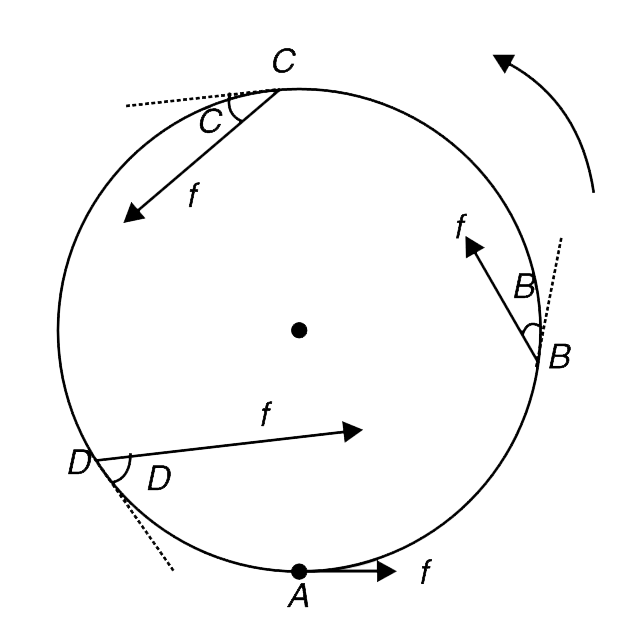
(b) A particle is moving along an expanding spiral (shown in fig) such that the normal force on the particle [i.e., component of force perpendicular to the path of the particle] remains constant in magnitude. The possible direction of acceleration(→a)of the particle has been shown at three points A, B and C on its path. At which of these points the direction of acceleration has been represented correctly.
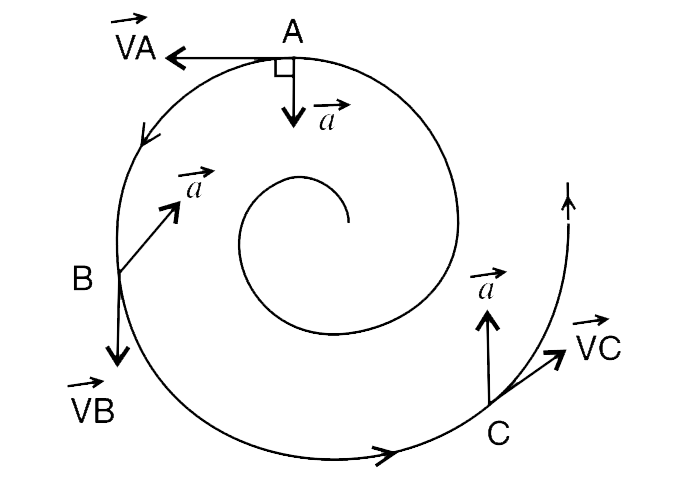
(c) A particle is moving in XY plane with a velocity . →v=4ˆi+2tˆjms−1 . Calculate its rate of change of speed and normal acceleration at t = 2 s.View SolutionABC is an isosceles right angled triangular refecting prism of average refractive index μ. When incident rays on face AB are parallel to face BC, then they emerges from Face AC, which are also parallel to Face BC as shown in figure-I. The prims capable to do so, known as Dove Prism. In figure II, the Dove Prism is used for dispersion of incident light containing red colour and violet colour only. The red colour and violet colour lights are separated (displaced) on screen by a distance Δl. In reality, each ray of any colour has some width, which can be designated as d. It is clear that an observer candistinguish the red and violet rays that emerges from prism only if Δl≥d. Otherwise the bundles of rays will overlap and mix.
[Given for Dove Prism in figure II: μR=√52,Δμ=μV−μR=0.02,√5=2.25,EF1m and AB=4cm]

Find the maximum value of width d of bundle of rays that can be resolved at the outlet of Dove Prism as shown in the figureIIView SolutionABC is an isosceles right angled triangular refecting prism of average refractive index μ. When incident rays on face AB are paralel to face BC, then they emerges from Face AC, which are also parallel to Face BC as shown in figure-I. The prims capable to do so, known as Dove Prism. In figure II, the Dove Prism is used for dispersion of incident light containing red colour and violet colour only. The red colour and violet colour lights are separated (displaced) on screen by a distance Δl. In reality, each ray of any colour has some width, whcih can be designated as d. It is clear that an observer candistinguish the red and violet rays that emerges from prism only if Δl≥d. Otherwise the bundles of rays will overlap and mix.
[Given for Dove Prism in figure II: μR=√52,Δμ=μV−μR=0.02,√5=2.25,EF1m and AB=4cm]

Choose the INCORRECT optionView Solution

